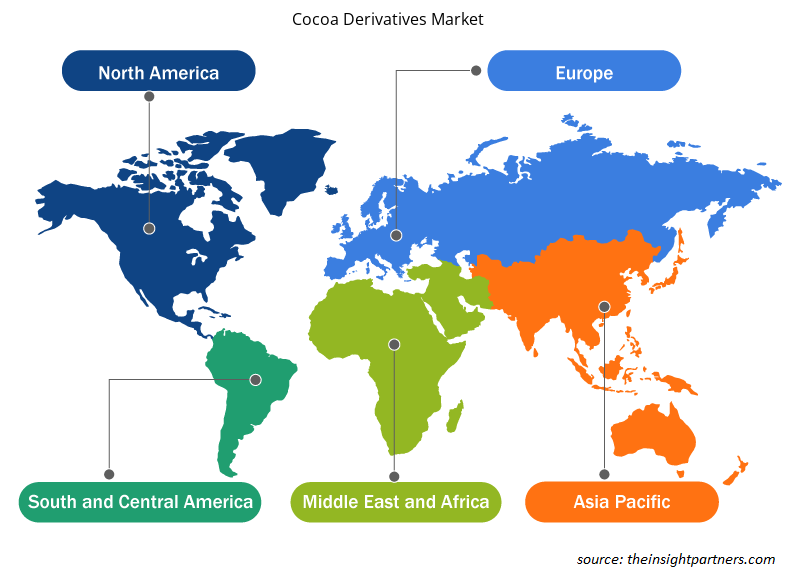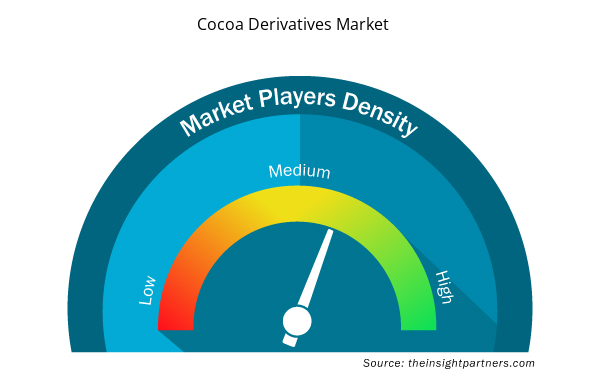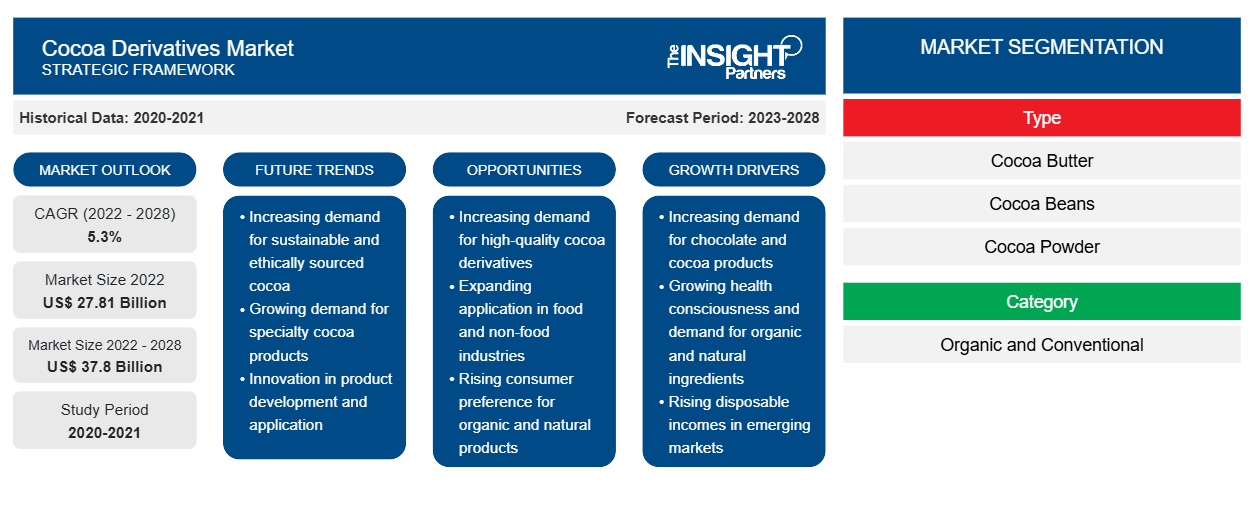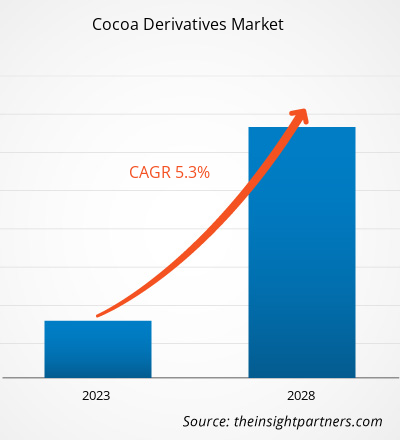ココアデリバティブ市場の規模は、2022年の278億713万米ドルから2028年には377億9986万米ドルに成長すると予想されており、2022年から2028年にかけて5.3%のCAGRを記録すると予測されています。
ココア誘導体は、ココアの加工から得られるココア製品です。ココア誘導体の種類には、カカオ豆、ココアバター、ココアパウダーなどがあります。これらの誘導体も、オーガニックと従来型のカテゴリーで入手できます。オーガニックおよびフェアトレード認証のカカオ豆の需要は、世界市場で高まっています。消費者は、全体的な健康を維持するのに役立つより安全な製品を消費する傾向があります。無農薬食品への関心の高まりは、有機栽培のカカオの需要にプラスの影響を与えています。有機農業研究所(FiBL)と国際有機農業運動連盟(IFOAM)による「World of Organic Agriculture 2022」レポートによると、2020年の世界の有機カカオの栽培面積は3.1%に達しました。さらに、リンツ&シュプルングリは、ヨーロッパでのオーガニックココア製品の売上が、ココア製品全体の売上よりもはるかに速いペースで成長していることを示しています。そのため、メーカーは、高まる需要に対応するために、ポートフォリオにオーガニック製品を追加しています。たとえば、バリーカレボーは、国内産でオーガニック認証を受けた非アルカリ化ココアパウダーを提供しています。
2022年には、ヨーロッパがココア誘導体市場で最大のシェアを占めました。アジア太平洋地域の市場は、予測期間中に最高のCAGRで成長すると予測されています。この地域の市場成長は、ヨーロッパ人の間でグルメチョコレートの人気の高まりに起因しています。そのため、さまざまな高級チョコレートブランドが、単一農園製品の調達に重点を置くとともに、製品を差別化する方法を求めてきました。このように、この地域では高品質のココアと単一起源のココアフレーバーの需要が高まっています。たとえば、フランスに本拠を置く世界最高級のチョコレート生産者であるヴァローナ社は、フランスの単一起源のココア農園であるマリアトリニダードサンチェスからカカオ豆を収穫しています。さらに、消費者の健康的な生活への傾向は、ココアバター、ココアパウダー、カカオ豆などの高品質のココア誘導体の需要を引き起こしています。
要件に合わせてレポートをカスタマイズする
このレポートの一部、国レベルの分析、Excelデータパックなど、あらゆるレポートを無料でカスタマイズできます。また、スタートアップや大学向けのお得なオファーや割引もご利用いただけます。
- このレポートの主要な市場動向を入手してください。この無料サンプルには、市場動向から見積もりや予測に至るまでのデータ分析が含まれます。
COVID-19パンデミックによるココアデリバティブ市場への影響
COVID-19パンデミックは、さまざまな国の経済や産業に影響を及ぼしました。北米、ヨーロッパ、アジア太平洋(APAC)、中南米(SAM)、中東アフリカ(MEA)でのロックダウン、旅行制限、事業停止は、食品・飲料業界を含むいくつかの業界の成長を妨げました。製造ユニットの停止は、グローバルサプライチェーン、製造活動、配送スケジュール、必須および非必須の製品の販売に混乱をもたらしました。2020年には、さまざまな企業で製品配送の遅延や製品の販売低迷が見られました。さらに、ヨーロッパ、アジア太平洋、北米のさまざまな国の政府による海外旅行禁止により、企業はコラボレーションやパートナーシップの計画を一時的に中止せざるを得ませんでした。これらすべての要因が2020年と2021年初頭にさまざまな業界を妨げ、さまざまな市場の成長を抑制しました。
社会経済状況の変化は、2020年の高級品の消費パターンに悪影響を及ぼしました。世界的危機の際に世界のいくつかの国の政府が課した制限により、パンデミックの最初の数か月間に生産量が需要を上回ったため、小規模ながらも重要なカカオ生産国のカカオを栽培している農家は経済的損失を被りました。これにより、カカオの価格が大幅に下落しました。国際ココア機関(ICCO)によると、ニューヨークでは、2021年1月のカカオ契約価格は平均で1トンあたり約2,528米ドルで、前年の価格(1トンあたり2,675米ドル)と比較して6%の低下を記録しました。さらに、パーソナルケアおよび食品・飲料業界の施設の閉鎖が、カカオデリバティブ市場のパフォーマンスに影響を与えました。
2021年、政府が以前に課した制限の緩和を発表したことで、いくつかの経済が活動を再開し、世界市場が活性化しました。さらに、メーカーはフル稼働を許可されたため、需要と供給のギャップやその他の影響を克服することができました。2021年までに世界の人口の大半がワクチン接種を完了したため、ココアデリバティブメーカーは事業を復活させるために生産活動の拡大に注力しました。
市場分析
主要プレーヤーによる戦略的展開がココアデリバティブ市場の成長を後押し
2020年9月、オラムグループはプロ向けのオラムココアを発売し、同社の高級デザーンココアパウダーをレストラン、ケータリング、パティスリーで利用できるようにしました。この戦略は、プロのシェフやパン職人からの高品質ココア原料の需要の高まりに応えることを目的としていました。市場の主要企業によるこのような戦略的展開は、今後数年間でココアデリバティブ市場の成長を促進すると予想されます。
タイプインサイト
タイプに基づいて、ココア誘導体市場は、カカオ豆、ココアバター、ココアパウダー、その他に分類されます。カカオ豆セグメントは2022年に最大の市場シェアを占め、ココアパウダーセグメントは予測期間中に最高のCAGRを記録すると予想されています。ココアパウダーは、カカオの木の果実から抽出されたカカオ豆を砕いて得られる無糖のパウダーです。チョコレートリキュールを圧搾してココアバターを除去し、残ったココア固形物を処理して、無糖の細かいココアパウダーを作ります。より良い風味、色、食感を求める消費者の傾向の高まりにより、ココアパウダーの需要が高まっています。
アプリケーションインサイト
用途に基づいて、ココア誘導体市場は食品および飲料、パーソナルケア、その他に分類されます。ココア誘導体は、ベーカリー製品、飲料、菓子、乳製品、スナックの製造に広く使用されています。しかし、クリーンラベル製品やビーガン製品に対する需要が高まり、ココアバター、ココアパウダー、ココアニブ、ココアリカーなどの植物由来の原料の売上が急増しています。したがって、食品および飲料業界で植物由来製品の需要が高まっていることが、ココア誘導体市場の成長を後押ししています。Olam International および Cargill, Incorporated は、食品および飲料用途のココア誘導体を提供する大手メーカーです。
Olam Group Ltd、Indcre SA、Cargill Inc、Natra SA、JB Foods Ltd、Ecuakao Group Ltd、United Cocoa Processor Inc、Barry Callebaut AG、Moner Cocoa SA、およびAltınmarka Gıda San ve Tic ASは、ココア派生商品市場で活動している主要企業です。これらの企業は、市場規模を拡大し、新たなトレンドを追うために、主に製品の革新に重点を置いています。
ココア派生商品市場の地域別分析
予測期間を通じてココアデリバティブ市場に影響を与える地域的な傾向と要因は、Insight Partners のアナリストによって徹底的に説明されています。このセクションでは、北米、ヨーロッパ、アジア太平洋、中東、アフリカ、南米、中米にわたるココアデリバティブ市場のセグメントと地理についても説明します。

- ココアデリバティブ市場の地域別データを入手
ココアデリバティブ市場レポートの範囲
| レポート属性 | 詳細 |
|---|---|
| 2022年の市場規模 | 278億1000万米ドル |
| 2028年までの市場規模 | 378億米ドル |
| 世界のCAGR(2022年 - 2028年) | 5.3% |
| 履歴データ | 2020-2021 |
| 予測期間 | 2023-2028 |
| 対象セグメント | タイプ別
|
| 対象地域と国 | 北米
|
| 市場リーダーと主要企業プロフィール |
|
ココアデリバティブ市場のプレーヤー密度:ビジネスダイナミクスへの影響を理解する
ココア誘導体市場は、消費者の嗜好の変化、技術の進歩、製品の利点に対する認識の高まりなどの要因により、エンドユーザーの需要が高まり、急速に成長しています。需要が高まるにつれて、企業は提供品を拡大し、消費者のニーズを満たすために革新し、新たなトレンドを活用し、市場の成長をさらに促進しています。
市場プレーヤー密度とは、特定の市場または業界内で活動している企業または会社の分布を指します。これは、特定の市場スペースに、その規模または総市場価値と比較して、どれだけの競合相手 (市場プレーヤー) が存在するかを示します。
ココア派生商品市場で事業を展開している主要企業は次のとおりです。
- オラムグループ株式会社
- インデックスSA
- カーギル株式会社
- ナトラSA
- JBフーズ株式会社
免責事項:上記の企業は、特定の順序でランク付けされていません。

- ココアデリバティブ市場のトップキープレーヤーの概要を入手
レポートの注目点
- 企業が効果的な長期戦略を策定するのに役立つ、ココア派生商品市場における進歩的な業界動向
- 先進国と発展途上国の市場プレーヤーが採用しているビジネス成長戦略
- 2022年から2028年までの市場の定量分析
- ココア誘導体の世界需要の推定
- ココアデリバティブ市場におけるバイヤーとサプライヤーの有効性を示すポーターのファイブフォース分析
- 競争市場の状況を理解するための最近の動向
- ココアデリバティブ市場における市場動向と展望、成長の原動力と制約
- 商業的利益を支える市場戦略を強調することで意思決定プロセスを支援する
- さまざまなノードにおけるココアデリバティブ市場の規模
- ココアデリバティブ業界の市場と成長動向の詳細な概要とセグメンテーション
- 有望な成長機会のあるさまざまな地域のココア派生商品市場の規模
- 過去2年間の分析、基準年、CAGRによる予測(7年間)
- PEST分析とSWOT分析
- 市場規模価値/数量 - 世界、地域、国
- 業界と競争環境
- Excel データセット



Report Coverage
Revenue forecast, Company Analysis, Industry landscape, Growth factors, and Trends

Segment Covered
This text is related
to segments covered.

Regional Scope
North America, Europe, Asia Pacific, Middle East & Africa, South & Central America

Country Scope
This text is related
to country scope.
よくある質問
The rising demand for cocoa-based confectioneries and the utilization of cocoa as a sustainable beauty ingredient by the cosmetic industry are some of the key driving factors for the cocoa derivatives market.
Based on application, personal care is the fastest-growing segment in the cocoa derivatives market due to its high antioxidant properties and its richness in flavanols.
Europe accounted for the largest share of the global cocoa derivatives market. The market growth is attributed to the increasing popularity of specialty chocolates among the European population which boost the demand for cocoa derivatives.
Based on the type, the cocoa beans segment accounted for the largest revenue share as it promotes healthy digestion due to their fibre content. The fibre content helps soften bowel movements, prevent haemorrhoids and help with other digestive conditions. it finds wide application in industries such as food & beverage, confectionery, and pharmaceuticals.
Increasing demand for organic and fairtrade cocoa derivatives is further expected to create lucrative opportunities for cocoa derivatives market growth.
The major players operating in the global cocoa derivatives market are Olam Group Ltd, Indcre SA, Cargill Inc, Natra SA, JB Foods Ltd , Ecuakao Group Ltd, United Cocoa Processor Inc, Barry Callebaut AG, Moner Cocoa SA, Altınmarka Gıda San ve Tic AS among few others.
Trends and growth analysis reports related to Food and Beverages : READ MORE..
The List of Companies - Cocoa Derivatives Market
- Olam Group Ltd
- Indcre SA
- Cargill Inc
- Natra SA
- JB Foods Ltd
- Ecuakao Group Ltd
- United Cocoa Processor Inc
- Barry Callebaut AG
- Moner Cocoa SA
- Alt?nmarka G?da San ve Tic AS
The Insight Partners performs research in 4 major stages: Data Collection & Secondary Research, Primary Research, Data Analysis and Data Triangulation & Final Review.
- Data Collection and Secondary Research:
As a market research and consulting firm operating from a decade, we have published and advised several client across the globe. First step for any study will start with an assessment of currently available data and insights from existing reports. Further, historical and current market information is collected from Investor Presentations, Annual Reports, SEC Filings, etc., and other information related to company’s performance and market positioning are gathered from Paid Databases (Factiva, Hoovers, and Reuters) and various other publications available in public domain.
Several associations trade associates, technical forums, institutes, societies and organization are accessed to gain technical as well as market related insights through their publications such as research papers, blogs and press releases related to the studies are referred to get cues about the market. Further, white papers, journals, magazines, and other news articles published in last 3 years are scrutinized and analyzed to understand the current market trends.
- Primary Research:
The primarily interview analysis comprise of data obtained from industry participants interview and answers to survey questions gathered by in-house primary team.
For primary research, interviews are conducted with industry experts/CEOs/Marketing Managers/VPs/Subject Matter Experts from both demand and supply side to get a 360-degree view of the market. The primary team conducts several interviews based on the complexity of the markets to understand the various market trends and dynamics which makes research more credible and precise.
A typical research interview fulfils the following functions:
- Provides first-hand information on the market size, market trends, growth trends, competitive landscape, and outlook
- Validates and strengthens in-house secondary research findings
- Develops the analysis team’s expertise and market understanding
Primary research involves email interactions and telephone interviews for each market, category, segment, and sub-segment across geographies. The participants who typically take part in such a process include, but are not limited to:
- Industry participants: VPs, business development managers, market intelligence managers and national sales managers
- Outside experts: Valuation experts, research analysts and key opinion leaders specializing in the electronics and semiconductor industry.
Below is the breakup of our primary respondents by company, designation, and region:

Once we receive the confirmation from primary research sources or primary respondents, we finalize the base year market estimation and forecast the data as per the macroeconomic and microeconomic factors assessed during data collection.
- Data Analysis:
Once data is validated through both secondary as well as primary respondents, we finalize the market estimations by hypothesis formulation and factor analysis at regional and country level.
- Macro-Economic Factor Analysis:
We analyse macroeconomic indicators such the gross domestic product (GDP), increase in the demand for goods and services across industries, technological advancement, regional economic growth, governmental policies, the influence of COVID-19, PEST analysis, and other aspects. This analysis aids in setting benchmarks for various nations/regions and approximating market splits. Additionally, the general trend of the aforementioned components aid in determining the market's development possibilities.
- Country Level Data:
Various factors that are especially aligned to the country are taken into account to determine the market size for a certain area and country, including the presence of vendors, such as headquarters and offices, the country's GDP, demand patterns, and industry growth. To comprehend the market dynamics for the nation, a number of growth variables, inhibitors, application areas, and current market trends are researched. The aforementioned elements aid in determining the country's overall market's growth potential.
- Company Profile:
The “Table of Contents” is formulated by listing and analyzing more than 25 - 30 companies operating in the market ecosystem across geographies. However, we profile only 10 companies as a standard practice in our syndicate reports. These 10 companies comprise leading, emerging, and regional players. Nonetheless, our analysis is not restricted to the 10 listed companies, we also analyze other companies present in the market to develop a holistic view and understand the prevailing trends. The “Company Profiles” section in the report covers key facts, business description, products & services, financial information, SWOT analysis, and key developments. The financial information presented is extracted from the annual reports and official documents of the publicly listed companies. Upon collecting the information for the sections of respective companies, we verify them via various primary sources and then compile the data in respective company profiles. The company level information helps us in deriving the base number as well as in forecasting the market size.
- Developing Base Number:
Aggregation of sales statistics (2020-2022) and macro-economic factor, and other secondary and primary research insights are utilized to arrive at base number and related market shares for 2022. The data gaps are identified in this step and relevant market data is analyzed, collected from paid primary interviews or databases. On finalizing the base year market size, forecasts are developed on the basis of macro-economic, industry and market growth factors and company level analysis.
- Data Triangulation and Final Review:
The market findings and base year market size calculations are validated from supply as well as demand side. Demand side validations are based on macro-economic factor analysis and benchmarks for respective regions and countries. In case of supply side validations, revenues of major companies are estimated (in case not available) based on industry benchmark, approximate number of employees, product portfolio, and primary interviews revenues are gathered. Further revenue from target product/service segment is assessed to avoid overshooting of market statistics. In case of heavy deviations between supply and demand side values, all thes steps are repeated to achieve synchronization.
We follow an iterative model, wherein we share our research findings with Subject Matter Experts (SME’s) and Key Opinion Leaders (KOLs) until consensus view of the market is not formulated – this model negates any drastic deviation in the opinions of experts. Only validated and universally acceptable research findings are quoted in our reports.
We have important check points that we use to validate our research findings – which we call – data triangulation, where we validate the information, we generate from secondary sources with primary interviews and then we re-validate with our internal data bases and Subject matter experts. This comprehensive model enables us to deliver high quality, reliable data in shortest possible time.


 このレポートの無料サンプルを入手する
このレポートの無料サンプルを入手する